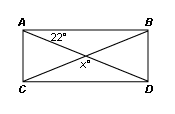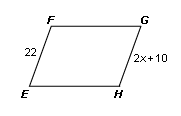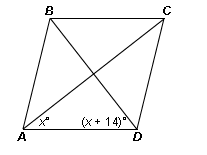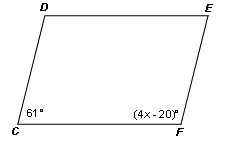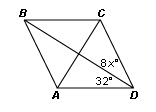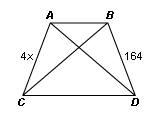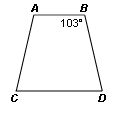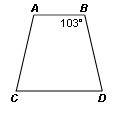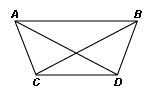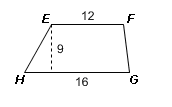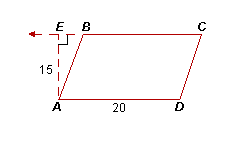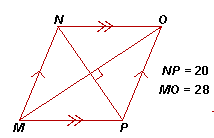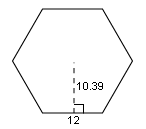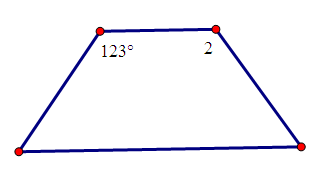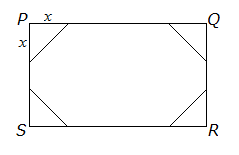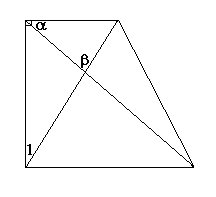Polygons And Quadrilaterals Test-period 1

This is your test on Polygons and Quadrilaterals. You are to complete it in class. You may only take it once.
- 1.
How many sides total does a heptagon and a decagon have together?
- A.
17
- B.
16
- C.
15
- D.
18
Correct Answer
B. 16Explanation
A heptagon has 7 sides, while a decagon has 10 sides. To find the total number of sides, we add the number of sides of both shapes together: 7 + 10 = 17. However, the given options do not include 17. The closest option is 16, which is the correct answer.Rate this question:
-
- 2.
What is the sum of the exterior angles of a 34-gon?
- A.
180
- B.
360
- C.
90
- D.
5760
Correct Answer
B. 360Explanation
The sum of the exterior angles of any polygon is always 360 degrees. This is a property of polygons, where the sum of the exterior angles is equal to a full rotation or 360 degrees. Therefore, the sum of the exterior angles of a 34-gon is 360 degrees.Rate this question:
-
- 3.
What is the sum of the interior angles of a hexagon?
- A.
360
- B.
180
- C.
720
- D.
1080
Correct Answer
C. 720Explanation
A hexagon has six sides, and the sum of the interior angles of any polygon can be found using the formula (n-2) * 180, where n is the number of sides. Therefore, the sum of the interior angles of a hexagon would be (6-2) * 180 = 4 * 180 = 720.Rate this question:
-
- 4.
What's the measure of each interior angle of a regular pentagon?
- A.
540°
- B.
90°
- C.
72°
- D.
108°
Correct Answer
D. 108°Explanation
A regular pentagon has five equal sides and five equal angles. To find the measure of each interior angle, we can use the formula (n-2) * 180° / n, where n is the number of sides of the polygon. In this case, n = 5. Plugging in the values, we get (5-2) * 180° / 5 = 3 * 180° / 5 = 540° / 5 = 108°.Rate this question:
-
- 5.
What is the measure of each exterior angle of a regular heptagon?
- A.
51.43°
- B.
360°
- C.
154.23°
- D.
1080°
Correct Answer
A. 51.43°Explanation
The measure of each exterior angle of a regular heptagon can be found by dividing 360° (the sum of all exterior angles in any polygon) by the number of sides, which in this case is 7. Therefore, each exterior angle of a regular heptagon measures 51.43°.Rate this question:
-
- 6.
How many sides does a regular polygon have if each exterior angle is 22.5°?
- A.
15
- B.
12
- C.
17
- D.
16
Correct Answer
D. 16Explanation
A regular polygon is a polygon that has all sides and angles equal. The sum of the exterior angles of any polygon is always 360°. In this case, if each exterior angle is 22.5°, we can divide 360° by 22.5° to find the number of exterior angles. This calculation gives us 16, which is the number of sides of the regular polygon.Rate this question:
-
- 7.
What is x in the rectangle below?
- A.
22°
- B.
158°
- C.
136°
- D.
68°
Correct Answer
C. 136°Explanation
The angle x in the rectangle is 136°. In a rectangle, opposite angles are equal. Since the given angles are not opposite each other, we can conclude that x is the angle opposite to the angle of 68°. Therefore, x is 136°.Rate this question:
-
- 8.
What is x in the parallelogram below?
- A.
90
- B.
6
- C.
22
- D.
12
Correct Answer
B. 6Explanation
In a parallelogram, opposite angles are equal. Therefore, the angle opposite to x is equal to x itself. Given that the angle opposite to x is 6, it can be concluded that x is equal to 6.Rate this question:
-
- 9.
What is x in the parallelogram below?
- A.
22
- B.
64
- C.
11
- D.
3
Correct Answer
A. 22 -
- 10.
What's the measure of angle E?
- A.
115°
- B.
25°
- C.
65°
- D.
90°
Correct Answer
C. 65°Explanation
Based on the given options, the measure of angle E is 65°.Rate this question:
-
- 11.
What is the measure of angle D?
- A.
65°
- B.
115°
- C.
90°
- D.
25°
Correct Answer
B. 115°Explanation
The measure of angle D is 115° because it is the only option that is not a right angle (90°), and it is also larger than the other two options (65° and 25°).Rate this question:
-
- 12.
In what shape/shapes are the diagonals perpendicular?
- A.
Rectangle
- B.
Rhombus
- C.
Square
- D.
Trapezoid
- E.
All of the above
Correct Answer
B. RhombusExplanation
A rhombus is a quadrilateral with all sides of equal length. In a rhombus, the diagonals intersect at right angles, making them perpendicular to each other. This property is unique to a rhombus and not present in other shapes listed in the options. Therefore, the correct answer is rhombus.Rate this question:
-
- 13.
In what shape/shapes do the diagonals bisect each other?
- A.
Parallelogram
- B.
Rectangle
- C.
Rhombus
- D.
Square
- E.
All of the above
Correct Answer
E. All of the aboveExplanation
The diagonals of a parallelogram, rectangle, rhombus, and square all bisect each other. This means that the diagonals divide each other into two equal parts, creating four congruent segments. Therefore, the correct answer is "All of the above."Rate this question:
-
- 14.
In what shape/shapes are the sides all congruent?
- A.
Rectangle
- B.
Rhombus
- C.
Parallelogram
- D.
Trapezoid
- E.
None of the above
Correct Answer
B. RhombusExplanation
A rhombus is the only shape among the options where all sides are congruent. In a rhombus, all four sides are equal in length, which means they are congruent. A rectangle also has congruent sides, but it is not the correct answer because not all rectangles have congruent sides. A parallelogram can have congruent opposite sides, but not necessarily all sides. A trapezoid does not have congruent sides, as it has at least one pair of parallel sides that are not congruent. Therefore, the correct answer is Rhombus.Rate this question:
-
- 15.
Medians exist in which of the following shape/shapes?
- A.
Parallelogram
- B.
Trapezoid
- C.
Rhombus
- D.
Square
- E.
All of the above
Correct Answer
B. TrapezoidExplanation
A median is a line segment that connects a vertex of a shape to the midpoint of the opposite side. In a trapezoid, there are two medians, each connecting a vertex to the midpoint of the opposite side. Therefore, medians exist in a trapezoid. However, medians do not exist in a parallelogram, rhombus, or square, as these shapes do not have sides that are divided into equal halves.Rate this question:
-
- 16.
Which of the following shapes has opposites sides that are congruent?
- A.
Parallelogram
- B.
Rectangle
- C.
Rhombus
- D.
Square
- E.
All of the above
Correct Answer
E. All of the aboveExplanation
All of the above shapes have opposite sides that are congruent. In a parallelogram, opposite sides are parallel and congruent. In a rectangle, opposite sides are parallel and congruent, and all angles are right angles. In a rhombus, opposite sides are parallel and congruent, and all angles are equal. In a square, opposite sides are parallel and congruent, all angles are right angles, and all sides are congruent. Therefore, all of these shapes have opposite sides that are congruent.Rate this question:
-
- 17.
Pi Day is Monday March 14th
- A.
True
- B.
False
Correct Answer
A. TrueExplanation
Pi Day is celebrated on March 14th because the date 3/14 represents the first three digits of the mathematical constant pi (π). Pi is the ratio of a circle's circumference to its diameter, and it is approximately equal to 3.14. Therefore, Pi Day is celebrated on March 14th (3/14) to honor and raise awareness about the importance of mathematics and the significance of pi in various scientific and mathematical calculations.Rate this question:
-
- 18.
In the rhombus, what is x?
- A.
90
- B.
38
- C.
128
- D.
180
Correct Answer
B. 38Explanation
In a rhombus, opposite angles are equal. Since one angle is given as 38, the opposite angle will also be 38. Therefore, the value of x is 38.Rate this question:
-
- 19.
2In the rhombus below, what is x?
- A.
40
- B.
90
- C.
80
- D.
45
Correct Answer
A. 40Explanation
In a rhombus, the opposite angles are equal. Since the angle opposite to x is 40 degrees, it means that x is also 40 degrees.Rate this question:
-
- 20.
In the parallelogram below, what is x?
- A.
139
- B.
119
- C.
34.75
- D.
20.25
Correct Answer
C. 34.75Explanation
The given parallelogram has opposite sides that are equal in length. The longer side measures 139 units, and since the opposite side is also equal in length, it must also measure 139 units. The shorter side measures 119 units, and since the opposite side is also equal in length, it must also measure 119 units. The diagonal of the parallelogram divides it into two congruent triangles. Using the Pythagorean theorem, we can find the length of the diagonal. The diagonal squared is equal to the sum of the squares of the two sides. So, 139 squared plus 119 squared equals the diagonal squared. Solving for the diagonal, we find that it is approximately 175.74 units. Since the diagonal is divided into two equal parts by the x value, each part is half of the diagonal. Therefore, x is equal to half of the diagonal, which is approximately 87.87 units.Rate this question:
-
- 21.
In the rhombus below, what is x?
- A.
7.25
- B.
32
- C.
4
- D.
97.25
Correct Answer
C. 4 -
- 22.
If ABCD is an Isosceles trapezoid, what is x?
- A.
164
- B.
41
- C.
45
- D.
160
Correct Answer
B. 41Explanation
In an isosceles trapezoid, the two non-parallel sides are congruent. This means that the angles opposite these sides are also congruent. Since x is one of these angles, it must be equal to the other angle opposite the other non-parallel side. Therefore, x is equal to 41.Rate this question:
-
- 23.
In the trapezoid below, what is the measure of angle A?
- A.
103°
- B.
77°
- C.
90°
- D.
180°
Correct Answer
A. 103°Explanation
The measure of angle A in a trapezoid is equal to the measure of angle D, which is the angle opposite to it. Since the given answer is 103°, it means that angle D is also 103°. Therefore, angle A is also 103°.Rate this question:
-
- 24.
In the trapezoid below, what is the measure of angle C?
- A.
103°
- B.
77°
- C.
90°
- D.
180°
Correct Answer
B. 77°Explanation
The measure of angle C in a trapezoid is always equal to the measure of angle A, which is the angle opposite to angle C. Since angle A is given as 77°, it can be concluded that angle C is also 77°.Rate this question:
-
- 25.
In the trapezoid below, what is x if AD=14 and BC=7+2x?
- A.
7
- B.
3.5
- C.
14
- D.
10.5
Correct Answer
B. 3.5Explanation
In a trapezoid, the parallel sides are called bases. In this case, AD and BC are the bases. Given that AD=14 and BC=7+2x, we can set up an equation to solve for x. We know that the bases of a trapezoid are parallel, so they must be equal in length. Therefore, we can set AD equal to BC and solve for x. 14=7+2x. Subtracting 7 from both sides gives us 7=2x. Dividing both sides by 2 gives us x=3.5. Therefore, the value of x is 3.5.Rate this question:
-
- 26.
Find the area:
- A.
1728
- B.
252
- C.
126
- D.
144
Correct Answer
C. 126Explanation
The given answer, 126, is the correct answer because it is the only option that is a factor of both 1728 and 252. To find the area, we need to divide the larger number (1728) by the smaller number (252). If we divide 1728 by 252, we get 6.85714285714. Since we are looking for a whole number, the only option that satisfies this condition is 126, which is 6 multiplied by 21.Rate this question:
-
- 27.
Find the area:
- A.
300
- B.
150
- C.
35
- D.
200
Correct Answer
A. 300 -
- 28.
Find the area:
- A.
120
- B.
60
- C.
23
- D.
30
Correct Answer
A. 120 -
- 29.
Find the area if
- A.
280
- B.
560
- C.
140
- D.
48
Correct Answer
A. 280 -
- 30.
Find the area:
- A.
124.68
- B.
62.34
- C.
748.08
- D.
374.04
Correct Answer
D. 374.04 -
- 31.
Find the area:
- A.
162
- B.
88
- C.
142
- D.
112
Correct Answer
C. 142 -
- 32.
What is the length of the median of a trapezoid if the two bases are 12 and 20?
- A.
16
- B.
32
- C.
240
- D.
120
Correct Answer
A. 16Explanation
The length of the median of a trapezoid can be found by taking the average of the lengths of the two bases. In this case, the two bases are 12 and 20. Adding them together and dividing by 2 gives us (12+20)/2 = 16. Therefore, the length of the median of this trapezoid is 16.Rate this question:
-
- 33.
How many sides does a pentagon have?
- A.
5
- B.
6
- C.
7
- D.
8
Correct Answer
A. 5Explanation
A pentagon is a polygon with five sides. Therefore, the correct answer is 5.Rate this question:
-
- 34.
The diagonals in all parallelograms bisect each other
- A.
True
- B.
False
Correct Answer
A. TrueExplanation
In a parallelogram, the opposite sides are parallel and congruent. As a result, the diagonals of a parallelogram bisect each other. This means that the point where the diagonals intersect divides each diagonal into two equal segments. Therefore, the statement that the diagonals in all parallelograms bisect each other is true.Rate this question:
-
- 35.
In a rhombus, the diagonals bisect the angles
- A.
True
- B.
False
Correct Answer
A. TrueExplanation
In a rhombus, the diagonals bisect the angles. This means that each diagonal divides the angle it intersects into two equal parts. This property is true for all rhombuses, as it is a defining characteristic of this geometric shape. Therefore, the correct answer is true.Rate this question:
-
- 36.
The diagonals in all parallelograms are congruent
- A.
True
- B.
False
Correct Answer
B. FalseExplanation
The statement is false because the diagonals in all parallelograms are not necessarily congruent. While the opposite sides of a parallelogram are always congruent, the diagonals can have different lengths. In some cases, the diagonals may be equal in length, but this is not a property that holds true for all parallelograms. Therefore, the correct answer is false.Rate this question:
-
- 37.
The legs in a trapezoid are always congurent
- A.
True
- B.
False
Correct Answer
B. FalseExplanation
The statement is false because the legs of a trapezoid are not always congruent. In a trapezoid, the legs are the two sides that are parallel to each other. These legs can have different lengths, so they are not necessarily congruent. Therefore, the correct answer is false.Rate this question:
-
- 38.
What is the equation for the sum of the interior angles of a polygon?
- A.
(n-2) * 360
- B.
N * 180
- C.
(n-2) * 180
- D.
360
Correct Answer
C. (n-2) * 180Explanation
The equation for the sum of the interior angles of a polygon is (n-2) * 180. This equation is derived from the fact that the sum of the interior angles of any polygon can be found by subtracting 2 from the number of sides (n) and then multiplying the result by 180. This equation holds true for all polygons, regardless of the number of sides.Rate this question:
-
- 39.
What is the equation for the area of a trapezoid?
- A.
A = b * h
- B.
A = 1/2 b * h
- C.
A = 1/2 D1 * D2
- D.
A = 1/2 * h * (b1 + b2)
Correct Answer
D. A = 1/2 * h * (b1 + b2)Explanation
The equation for the area of a trapezoid is A = 1/2 * h * (b1 + b2). This formula calculates the area by taking the average of the lengths of the two parallel bases (b1 and b2) and multiplying it by the height (h) of the trapezoid. Since a trapezoid has two parallel sides and two non-parallel sides, this formula takes into account the difference in lengths of the bases and the height to accurately calculate the area.Rate this question:
-
- 40.
What is the equation for the area of a rhombus?
- A.
A = b * h
- B.
A = 1/2 b * h
- C.
A = 1/2 D1 * D2
- D.
A = 1/2 * h * (b1 + b2)
Correct Answer
C. A = 1/2 D1 * D2Explanation
The equation for the area of a rhombus is given by A = 1/2 D1 * D2. This formula calculates the area by multiplying half of the length of one diagonal (D1) by the length of the other diagonal (D2). The diagonals of a rhombus are perpendicular bisectors of each other, so multiplying them and dividing by 2 gives the area of the rhombus.Rate this question:
-
- 41.
What is the equation for the area of a parallelogram?
- A.
A = b * h
- B.
A = 1/2 b * h
- C.
A = 1/2 D1 * D2
- D.
A = 1/2 * h * (b1 + b2)
Correct Answer
A. A = b * hExplanation
The equation for the area of a parallelogram is given by multiplying the base length (b) by the height (h). This formula is derived from the fact that the area of a parallelogram is equal to the product of its base and height.Rate this question:
-
- 42.
Consecutive angels in a parallelogram are ___.
- A.
Congruent
- B.
Complimentary
- C.
Supplementary
- D.
None of the above
Correct Answer
C. SupplementaryExplanation
Consecutive angles in a parallelogram are supplementary because a parallelogram has opposite sides that are parallel and equal in length, and opposite angles that are congruent. Since the opposite angles are congruent, the sum of any two consecutive angles in a parallelogram is 180 degrees, making them supplementary.Rate this question:
-
- 43.
What is the equation for the area of a parallelogram?
- A.
A = b * h
- B.
A = 1/2 b * h
- C.
A = 1/2 D1 * D2
- D.
A = 1/2 * h * (b1 + b2)
Correct Answer
A. A = b * hExplanation
The equation for the area of a parallelogram is A = b * h. This formula represents the area of a parallelogram as the product of the base (b) and the height (h) of the parallelogram.Rate this question:
-
- 44.
All squares are parallelograms
- A.
True
- B.
False
Correct Answer
A. TrueExplanation
All squares are parallelograms because a square is a special type of parallelogram where all four sides are equal in length and all four angles are right angles. Since a square satisfies all the properties of a parallelogram, it can be concluded that all squares are parallelograms.Rate this question:
-
- 45.
What is the measure of angle 2 in the isosceles trapezoid below?
- A.
123°
- B.
57°
- C.
33°
- D.
180°
Correct Answer
A. 123°Explanation
In an isosceles trapezoid, the two base angles are congruent. Since angle 2 is one of the base angles, it must also measure 123°.Rate this question:
-
- 46.
The rectangle shown below is 21 m long and 11 m wide. If four congruent triangles are removed from the rectangle with x = 4 m, then what will be the area of the remaining figure?
Correct Answer
199Explanation
After removing the four congruent triangles, the remaining figure will be a rectangle with dimensions of 21 m and 11 m. The area of a rectangle is calculated by multiplying its length by its width. Therefore, the area of the remaining figure is 21 m * 11 m = 231 m². However, since the question asks for the area of the remaining figure after removing the triangles with a width of x = 4 m, we need to subtract the area of these triangles from the total area. Each triangle has a base of 4 m and a height of 11 m, so the area of each triangle is (1/2) * 4 m * 11 m = 22 m². Since there are four triangles, the total area of the triangles is 4 * 22 m² = 88 m². Therefore, the area of the remaining figure is 231 m² - 88 m² = 143 m².Rate this question:
- 47.
What is measure of angle 1 if α = 36° and β = 84°?
Correct Answer
30Explanation
Given that α = 36° and β = 84°, we need to find the measure of angle 1. To do this, we can use the fact that the sum of the angles in a triangle is 180°. Since angle α and angle β are already given, we can subtract their measures from 180° to find the measure of angle 1. Therefore, angle 1 = 180° - 36° - 84° = 60°. Hence, the measure of angle 1 is 60°.Rate this question:
Quiz Review Timeline +
Our quizzes are rigorously reviewed, monitored and continuously updated by our expert board to maintain accuracy, relevance, and timeliness.
-
Current Version
-
Mar 22, 2023Quiz Edited by
ProProfs Editorial Team -
Mar 10, 2011Quiz Created by
Smatook
 Back to top
Back to top



